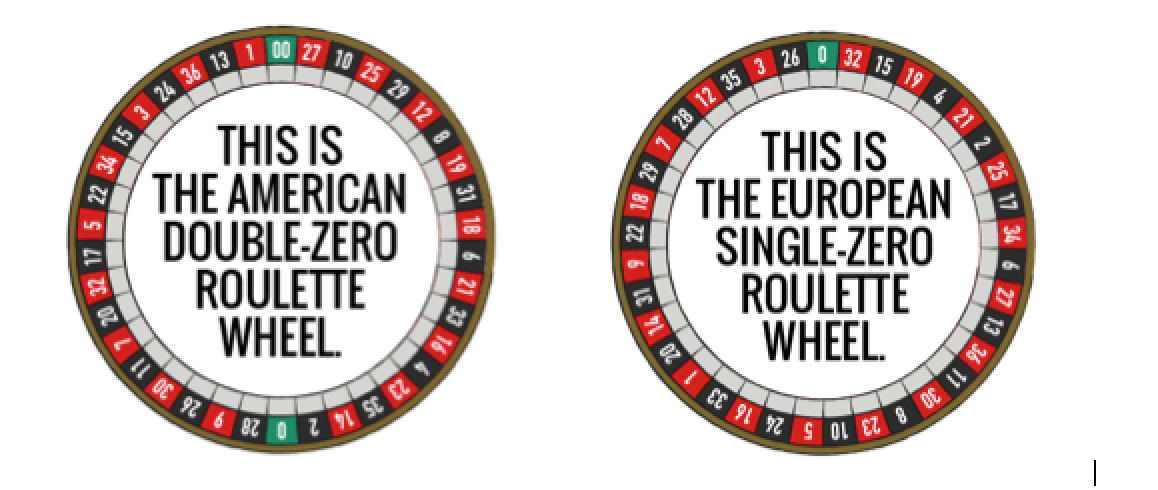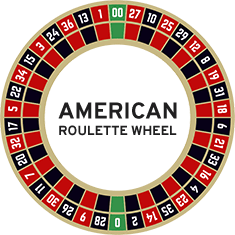Roulette Wheel With 0 And 00
Zero and double-zero — 0 and 00 — are green. So, American roulette has 38 sectors on the wheel. And in American roulette players have chips of their own colors: every player gets a set of certain color chips to differ from other players. It is convenient. The American Roulette rules are quite simple and almost the same as in European Roulette. A Look at 0, 00 and Row Payouts in Roulette Published on August 18th, 2018 8:40 pm EST There are two types of roulette wheels - the American roulette wheel and the European roulette wheel. The American roulette wheel features the green 0 and 00, while the European roulette wheel features just the single green 0.
If you look closely at the roulette wheel you will notice that some roulette wheels have a single 0 and some have a 0 and a 00. Is one game better than the other? Does it matter which game you play? These are questions often asked by players who notice the difference, and for those players that never noticed the difference you will find out why you need to start paying better attention. It can have a huge effect on your wallet.
There are two different roulette wheels. The European (Euro) wheel has a single 0 and the American wheel has both the 0 and 00. This doesn’t seem like much of a difference but it has a HUGE impact on the “house edge” (casino advantage). The American wheel has a house advantage of 5.26% which is not very good for the player. The Euro wheel basically cuts that advantage in half (2.7%) by simply removing the 00. That means roulette players should always play the Euro wheel when available.
If the 0 or 00 were not on the board it would take away the casino advantage. When a player bets red or black he thinks he is getting an even odds bet. He thinks he has a 50% chance of being right. If this was true the casino would not be profitable, there would be no built-in house advantage. That green spot or spots makes all the difference in the world and insures that the casino will be profitable in the long-run.
In general, the odds of roulette are not very good for the player, but the biggest tip that can save you a lot of money is ALWAYS play on a wheel that only has one 0.
Mechanical systems are systems which rely on the inherent flaws of a roulette wheel as a mechanical device or contiguous number spans across the wheel layout. This is a fundamental difference in strategy between the way that a table game and a computer generates random numbers.
Roulette Wheels For Sale

The basic principle underlying mechanical betting systems is exploiting the flaw in the way that the machine generates the numbers. As opposed to an electronic random number generator where any number is theoretically independent of any other number, a wheel is constructed with numbers situated permanently adjacent to one another. Therefore the numbers are not completely independent to one another because if the ball is right on the edge of falling from one cup to another, the number those cups represents are fixed. This can be especially useful when using Table clocking to determine a biased wheel, but as technology is making finding a biased wheel very difficult, the underlying theory is still interesting to consider. These systems are generally reserved for the American tables because it’s next to impossible to create contiguous sets on the European layout. However the casinos have solved this problems and already have special announce bets that can make this process easier.
If the ball is predestined to fall a certain region of the wheel (the 0 pocket for example), and you cover the four numbers to each side of the 0 {12,35,3,26,0,32,15,19,4}, as the ball jostles and bounces it is more likely to land in the pockets immediately next to the number than the other side of the wheel. However covering these numbers, with the same relative return, and without dropping a ton of chips is the challenge. Finding a betting system that most efficiently covers the numbers on the region of the board is the challenge to the mechanical system.
In this author’s opinion, this is the ONLY system worth exploring with real money in a casino – or buy a wheel and try it at home, but as of the time of this writing (2008) good professional 30” wheels cost around $4000, and a 27” around $2000. When one considers some systems can be explored with a bankroll of less than $100, it may be worth hitting a casino first.
What makes this most interesting is that mathematically the odds don’t change. Covering 24 numbers no matter where they are has the same probability as placing a bet which covers the numbers in sequence around the wheel. Perhaps it’s just a visceral reaction, but there have been many times where the ball seems to land in the pocket for the number which was bet only to have it slide one pocket over. I don’t know physics well enough to say if there is any reason why covering a region of numbers on a roulette wheel is more advantageous than not, but it just feels right. Besides the math has proved ineffectual.
There is only one book that I have been able to find which covers this in any great detail; Beating the Casinos at Their Own Game by Peter Svoboda ISBN 0-7570-0005-3. I make direct references to this source only because this particular section of this book is available on Google Books. This book also covers several other games in interesting ways and I highly recommend buying a copy or getting it from the interlibrary loan from your local library.
Mr. Svoboda goes into several systems and makes several interesting points, but one thing which he does not stress is that it is VITAL to find a roulette wheel with the exact same layout order as the one he uses in his book. It is possible that a wheel could look very similar but have a different order to their numbering which would require the player to analyze that particular arrangement and betting strategy. For instance I have seen some antique tables which have a reversed layout where the 2 is on the left of the 0 as opposed to the right, however everything else was in the same order so this may be a moot point.
The thing that I really like is that Mr. Svoboda also makes all of his systems mathematically related to winning percentages, and his strategies cover sectors of the wheel rather than sections of the layout. Additionally they fit within the constraints of the table limits imposed by most US casinos.
I’ll go into this more later.

Standing Systems[edit]
Standing systems (for lack of a better term) are those where the same bet is played on the same locations irregardless of previous wins or losses. This is opposed to progressive systems as described in the next section.
System 1[edit]
On the American layout, the best known contiguous bet combination is based on the center column. That placement covers the span from 23 to 5 (clockwise) with five gaps {0, 7, 9, 23, and 30}, and it only includes two numbers {8 and 29} which are outside the span. This covers a span width of 15 numbers which is almost exactly two fifths of the wheel.
This bet can be played two different ways.
- Place 4 chips on the center column and one chip on each of the numbers in set {0, 7, 9, 28, and 30}
- Return: If the numbers {2, 5, 8, 11, 14, 17, 20, 23, 26, 29, 32, 35} hit, then the return is: (4*2)-5=3. If the numbers {0, 7, 9, 28, 30}hit, then the return is: (1*35)-(4+4)=27. If the numbers {00, 1, 3, 4, 6, 10, 12, 13, 15, 16, 18, 19, 21, 22, 24, 25, 27, 31, 33, 34, 36} hit, then the return is -9.
- Place 1 chip each on two street bets {7, 8, 9} and {28, 29, 30}, and one chip on 0, and two chips on the center column.
- Return: If the numbers {2, 5, 11, 14, 17, 20, 23, 26, 32, 35} hit, then the return is: (2*2)-3=1. If the number {0} hits, then the return is (1*35)-4=31. If the numbers {7, 9}or {28, 30} hit, then the return is: (1*11)-4=7. If the numbers {8 or 29} hit, then the return is ((2*2)+(1*11))-2=13. If the numbers {00, 1, 3, 4, 6, 10, 12, 13, 15, 16, 18, 19, 21, 22, 24, 25, 27, 31, 33, 34, 36} hit, then the return is -5.
System 2[edit]
This combines two spans to cover 23 of the 38 numbers on the wheel.
- Place 1 chip on each of the 4 street bets {1, 2, 3}, {13, 14, 15}, {22, 23, 24}, and {34, 35, 36}. This is the first span. Place 1 chip on each of the two street bets {4, 5, 6} and {31, 32, 33}, and place 1 chip on each of the two splits {16, 19} and {18, 21}.
- Return: If the numbers {1, 2, 3, 4, 5, 6, 13, 14, 15, 22, 23, 24, 31, 32, 33, 34, 35, 36} hit, then the return is: (1*11)-7=4. If the number {16, 19, 18, 21} hit, then the return is: (1*17)-7=10. If the numbers {0, 00, 7, 8, 9, 10, 11, 12, 17, 20, 25, 26, 27, 28, 29, 30} hit, the return is -8.
Progressive Systems[edit]
Progressive systems change depending on the previous win/loss history. These systems are based upon the mechanical layout as opposed to statistical systems as described in this chapter.